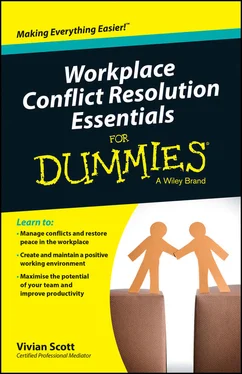Deciphering group dynamics
Two employees can completely understand each other and work like a well-oiled machine. Then a third co-worker joins the team, and now you have group dynamics in play. Wow, that changes everything! A team that’s cohesive and meeting its goals can be exhilarating from management’s perspective. But if cliques form and co-workers start looking for allies to enlist in power plays behind closed doors, communication breaks down.
Teams have a propensity to label members – the caretaker, the go-to guy, the historian and so on. Employees start to make assumptions based on the labelled roles, such as assuming that the go-to guy will happily accept any assignment you give him. Conjecture based on limited or selective information causes miscommunication, misunderstandings and, ultimately, conflict.
To address what happens when members of a group are undergoing difficulties, investigate how and when the problem started and determine if the problem stems from just a few staff members or if the impact is so great that you need to tackle the problem with the entire team. And flip to Chapter 3 Конец ознакомительного фрагмента. Текст предоставлен ООО «ЛитРес». Прочитайте эту книгу целиком, купив полную легальную версию на ЛитРес. Безопасно оплатить книгу можно банковской картой Visa, MasterCard, Maestro, со счета мобильного телефона, с платежного терминала, в салоне МТС или Связной, через PayPal, WebMoney, Яндекс.Деньги, QIWI Кошелек, бонусными картами или другим удобным Вам способом.
for more information on the way group dynamics can contribute to conflict.
Assessing your own role
Something you’re either doing or not doing may be causing friction on your team, and you may not even know what it is. Most people in conflict tend to spend more time thinking about what the other person is doing than looking at their own behaviour and attitudes toward the difficulty.
Chapter 4 Конец ознакомительного фрагмента. Текст предоставлен ООО «ЛитРес». Прочитайте эту книгу целиком, купив полную легальную версию на ЛитРес. Безопасно оплатить книгу можно банковской картой Visa, MasterCard, Maestro, со счета мобильного телефона, с платежного терминала, в салоне МТС или Связной, через PayPal, WebMoney, Яндекс.Деньги, QIWI Кошелек, бонусными картами или другим удобным Вам способом.
outlines some of the common missteps that colleagues, and especially managers, make in their attempts to handle problems at work. I discuss ways you may be unwittingly pitting team members against each other, address the dreaded micromanaging accusation, and explain how underrepresenting your team to the higher-ups may unite them in a way that puts you at the centre of a storm.
When I meet with clients in conflict, I prefer to use a tried-and-true mediation process that looks at both the surface issues and the underlying causes for the difficulty. In this section, I show you why mediation is your best bet for a long-term solution and improved working relationship.
Following eight steps to a resolution
Using a solid process to mediate a meeting between co-workers in conflict gives you a foundation on which to manage and monitor the difficulty. Follow these steps from a professional mediation process:
1. Do preliminary planning and setup:Carefully investigate who’s involved and what you believe the issues are, and invite the parties to discuss the matter with you. Provide a private, comfortable and confidential environment for the meeting.
2. Greet and discuss the process:Explain your role as a neutral facilitator and go over the ground rules, including your expectation for open minds and common courtesy.
3. Share perspectives:Give each person an opportunity to share her point of view and discuss the impact the conflict has had on her. Reflect, reframe and neutralise emotional content while honouring the spirit of what she’s sharing.
4. Build an agenda:Allow both parties to create a list of topics (not solutions) they want to discuss. The list acts as a road map that keeps the discussion on track.
5. Negotiate in good faith:As co-workers discuss initial ideas for solutions, set the tone by listening to any and all ideas. Brainstorm and play out how suggestions might work and whether they satisfy what’s most important to the employees.
6. Hold private meetings as necessary:Confidentially explore what’s keeping each from moving forward, and discuss what each is willing to do (or ask for) in the spirit of progress and real resolution.
7. Craft agreements:Bring employees back together and let them share, if they so choose, any discoveries they made during the private meeting sessions. Begin to narrow down solutions and come to an agreement (with details!) on who will do what and when.
8. Monitor follow-through:Keep track of progress, address hiccups and refine as appropriate.
Facilitating a conversation between two people
Before you begin the mediation process, you need to consider the following:
 A suitable meeting space:You want the employees to feel comfortable enough in the meeting location to open up about the real issues. Meet in a place that has lots of privacy and is seen as neutral territory.
A suitable meeting space:You want the employees to feel comfortable enough in the meeting location to open up about the real issues. Meet in a place that has lots of privacy and is seen as neutral territory.
 Confidentiality:You need to build trust for a mediation conversation (see
Confidentiality:You need to build trust for a mediation conversation (see Chapter 6 Конец ознакомительного фрагмента. Текст предоставлен ООО «ЛитРес». Прочитайте эту книгу целиком, купив полную легальную версию на ЛитРес. Безопасно оплатить книгу можно банковской картой Visa, MasterCard, Maestro, со счета мобильного телефона, с платежного терминала, в салоне МТС или Связной, через PayPal, WebMoney, Яндекс.Деньги, QIWI Кошелек, бонусными картами или другим удобным Вам способом.
for details on setting up a meeting), so agreeing to keep the conversation between the colleagues is a must, whether you act as mediator or bring in an outside expert.
 Time and interruptions:You probably want to set aside up to four hours to work through the issues, and you want to clear your schedule of other responsibilities so that the meeting isn’t interrupted.
Time and interruptions:You probably want to set aside up to four hours to work through the issues, and you want to clear your schedule of other responsibilities so that the meeting isn’t interrupted.
When you make the decision to mediate a conversation between feuding parties, a few things change for you. It’s imperative that you walk a fine line between manager or colleague and mediator. As a manager, you have the power to make decisions; as a mediator, you have the power to put the onus on the employees and act as a neutral third party.
Читать дальше

 A suitable meeting space:You want the employees to feel comfortable enough in the meeting location to open up about the real issues. Meet in a place that has lots of privacy and is seen as neutral territory.
A suitable meeting space:You want the employees to feel comfortable enough in the meeting location to open up about the real issues. Meet in a place that has lots of privacy and is seen as neutral territory. Confidentiality:You need to build trust for a mediation conversation (see
Confidentiality:You need to build trust for a mediation conversation (see  Time and interruptions:You probably want to set aside up to four hours to work through the issues, and you want to clear your schedule of other responsibilities so that the meeting isn’t interrupted.
Time and interruptions:You probably want to set aside up to four hours to work through the issues, and you want to clear your schedule of other responsibilities so that the meeting isn’t interrupted.










